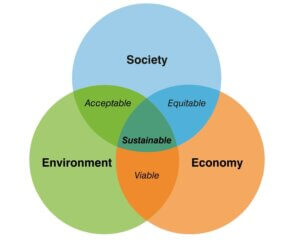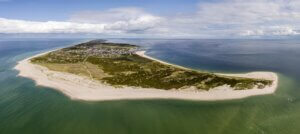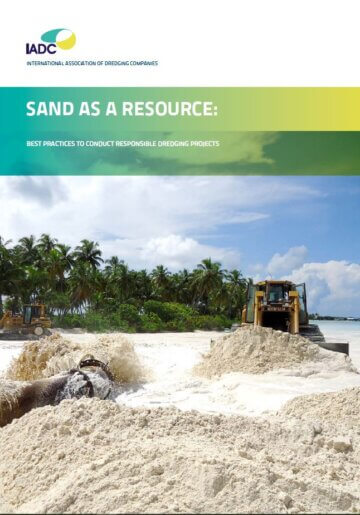The paper Sand as a resource: Best practices to conduct responsible dredging projects presents best practices for optimal use of scarce sand resources, on both project and operational levels. Every stage of a project presents opportunities to increase the sustainability of sand extraction. The paper is available free of charge.
Scope of the paper
For hundreds of years, dredging activities have shaped the interface between land and water to support a variety of human activities including navigation, coastal protection, flood risk management, as well as residential, tourist, commercial, agricultural and industrial activities. The use of dredging to achieve these purposes has always been guided by an understanding of the costs and benefits. The increasing tension between human development and planetary resilience urges us to rethink the way we work and live. The dredging sector is no exception. It uses sand as a building block to create infrastructure projects for social and economic development. At the same time, the increasing quantities extracted and its impacts on  environment and society raise concerns. According to the UN Environmental Programme (UNEP), 50 billion m3 sand is mined annually. Of this amount however, only a small percentage (2-4%) is dredged by dredging companies. As a sector, the dredging industry has extensive expertise in the sustainable extraction of sand. For this reason, its goal is to share its experience and findings with a broader audience to advise other industries and stakeholders in sustainable practices. Taking these concerns to heart is the shared responsibility of dredging contractors, project designers, project owners and authorities.
environment and society raise concerns. According to the UN Environmental Programme (UNEP), 50 billion m3 sand is mined annually. Of this amount however, only a small percentage (2-4%) is dredged by dredging companies. As a sector, the dredging industry has extensive expertise in the sustainable extraction of sand. For this reason, its goal is to share its experience and findings with a broader audience to advise other industries and stakeholders in sustainable practices. Taking these concerns to heart is the shared responsibility of dredging contractors, project designers, project owners and authorities.
The path towards sustainable use of sand is set out in ten recommendations formulated by UNEP[1]. IADC builds on this from the perspective of the dredging industry and directly refers to UNEP’S recommendation number 7, “Establish best practices and national standards, and a coherent international framework”. Keeping pace on this path requires the combined efforts of authorities, project owners, stakeholders, project designers and the industry. When all actors contribute within their field of competence and responsibility, opportunities can be seized to significantly reduce negative impacts on the environment and society as well as increase positive contributions.
[1] UNEP, Sand and Sustainability: 10 strategic recommendations to avert a crisis, 2022.
The dredging industry has an important part to play in seizing these opportunities. Operating globally, dredging contractors are working within a wide variety of physical, environmental, social, and legal conditions. Their first-hand experience can serve as a guide to formulating recommendations for responsible use of sand resources.
Content of the paper

This paper presents best practices for optimal use of scarce sand resources, on both project and operational levels. Every stage of a project presents opportunities to increase the sustainability of sand extraction. Key takeaways are:
- Performing and adhering to an Environmental and Social Impact Assessment (ESIA) are key to finding consensus about conditions and requirements for sand extraction;
- Impact mitigation and nature-inspired design start with monitoring and understanding the physical and ecological processes involved;
- Dredging in or near sensitive sites with high natural or cultural value is only feasible with extensive monitoring, adherence to strict limits and adequate supervision;
- Beneficial use of dredged sediment from capital and maintenance dredging projects is an alternative to sand extraction;
- Stakeholder engagement addresses concerns and unlocks potentials;
- Adaptive management counters risks and uncertainties associated with dredging projects;
- Appropriate procurement processes are able to prioritise project objectives;
- Large marine infrastructure projects entail opportunities to involve the local socio-economic community;
- Incentives for investment in innovation, safety culture and impact mitigation measures encourage improved practices; and
- Transparency about activities, with publicly available monitoring data and warning triggers, helps to maintain focus on impacts and to obtain project acceptance.
The paper is initiated and presented by the Sustainability Committee of IADC.
Authors
Jan Fordeyn (Jan De Nul), Tom Janssens (DEME), Sjon Kranendonk (Van Oord Dredging and Marine Contractors) and Thomas Vijverberg (Royal Boskalis)
Reviewers
Marsha Cohen (IADC), Marc Huygens (DEME), Thijs Oomen (Van Oord) and Erik van Eekelen (Van Oord Dredging and Marine Contractors)
IADC Sustainability Committee members
Frank Verhoeven (IADC), Rene Kolman (IADC), Jaap van Thiel de Vries (Royal Boskalis), Robert de Bruin (Van Oord Dredging and Marine Contractors), Marc Huygens (DEME), Jiska Verhulst (DEME) and Jan Fordeyn (Jan De Nul)

TAGS
- Adaptive monitoring
- Beneficial use of Sediments
- Building with Nature
- Climate Change
- coastal protection
- Coral reefs
- Deltas
- Early Contractor Involvement
- Ecosystem Services
- Emissions
- ENVIRONMENT
- Environment publication
- Environmental Impact Assessment
- Environmental Monitoring
- Flood Defence
- Geological Data
- Harbours
- IADC
- IADC publication
- Infrastructure
- Mangroves
- nature based solutions
- Port Infrastructures
- PORTS
- Publication
- Sand
- Sand as a resource
- sandscaping
- Stakeholders
- Sustainability
- Sustainable
- Sustainable Development Goals
- Wetlands

